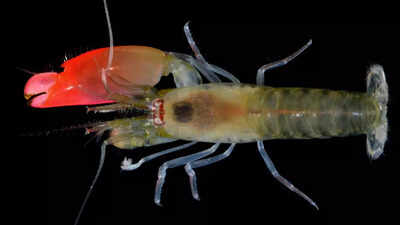Being called a "shrimp" might not evoke images of strength or intimidation, but the pistol shrimp, a remarkable marine creature, shatters that stereotype. Despite its small size, the pistol shrimp wields an incredible power that has interfered with military operations, inspired a superhero, and even contributed to climate change research.Also known as the snapping shrimp, this sea critter has earned its reputation through something seemingly playful: bubbles.
However, these aren't just any bubbles—they are louder than a gunshot and generate intense heat, making the pistol shrimp one of the ocean's most formidable creatures.
Fascinating facts about pistol shrimp you didn’t know
Bubble bulletsPistol shrimp use their "bubble bullets" for hunting, digging, and self-defence. Their specialized claw, nearly half their body length, creates a loud snap by forming a bubble. When the shrimp snaps its claw shut, water is expelled at high speed, forming a lethal bubble.As the bubble collapses, it produces a shockwave and an incredibly loud sound of 218 decibels—louder than a gunshot. This sound is brief, but the bubble's collapse generates intense heat of up to 8,000°F (4,427°C), four times hotter than lava. The heat dissipates quickly, though it can be deadly to creatures caught directly in its path.
Regeneration and adaptabilityWhile the large snapper claw is their main weapon, the smaller claw also has a unique ability. If a shrimp loses its large claw during an attack, the smaller claw will transform into a new snapper. This remarkable regeneration allows them to quickly recover and regain their powerful defence mechanism.
Cooperative creaturesDespite their reputation as aggressive hunters, some species of pistol shrimp live in colonies for protection. A few even form partnerships with other species, such as gobies, small fish that share burrows with shrimp in exchange for acting as lookouts. Most pistol shrimp inhabit coral reefs or seagrass beds, where their snapping indicates a healthy ecosystem.
Mimicry and deceptionPistol shrimp are also known for their impressive mimicry skills. Some species can imitate the sounds of other marine creatures, such as fish, to trick potential prey or rivals. This ability enhances their hunting efficiency and survival in their underwater environments.
Diverse habitatsPistol shrimp are adaptable and can be found in a range of habitats, from shallow coral reefs and seagrass beds to deeper ocean floors. Their ability to thrive in different environments showcases their versatility and resilience as a species.
Communication through clickingPistol shrimp use their distinctive snapping sound not only for hunting but also for communication. They produce a series of clicks to communicate with each other, which helps in coordinating activities within their colonies and maintaining social bonds.
The speed of the snapThe snapping action of the pistol shrimp’s claw is incredibly fast, reaching speeds of over 80 km/h (50 mph). This rapid movement is essential for creating the high-speed bubble and generating the powerful shockwave that makes the shrimp such an effective hunter.
Involvement in WWIIThe pistol shrimp posed a surprising problem for the U.S. Navy during World War II. Its snapping sound interfered with sonar systems used to detect enemy ships. The Navy had to work with scientists from the University of California to identify the source and train sonar operators to recognize the shrimp’s sounds, distinguishing them from potential threats.
Inspiring clean energy researchResearchers in England are studying pistol shrimp to replicate their snapping mechanism for fusion power, a process that powers the sun. By creating high-velocity projectiles like the shrimp’s bubble, they aim to harness this ability to generate clean, safe energy, aiding in the fight against climate change.
Superhero statusIn Netflix’s Project Power, Jamie Foxx’s character gains pistol shrimp powers, using them to turn raindrops into high-speed projectiles that obliterate anything in their path. It’s an unlikely source of inspiration for a superhero, but it showcases just how mighty these little creatures are.
Also read:Unravelling the journey of the iconic Baobab tree; new genomic study sheds light